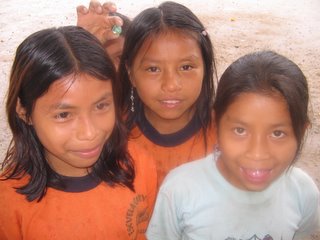Ecotrackers en la Biósfera del Sumaco: Mushullacta
La Biosfera del Sumaco es una área protegida en la Amazonía, que tiene una de las mayores gamas de biodiversidad del Mundo, con 6 diferentes pisos climáticos. (The Sumaco Biosphere is a protected area in the Amazon, that is one of the most biodiverse places in the world, with 6 different climates.)
Wednesday, November 23, 2005
Julia Stewart-David 24 September-15 October 2005
I spent three very tranquil weeks in the small, friendly community of Mushullacta, teaching English and participating in Community activities - learning a great deal about their way of life. Every morning I would wake up to the sounds of the children gathering at school - some walking almost an hour along muddy trails from their fincas. I taught two classes every day (levels 4-5, ages 8-9 and levels 6-7 ages 10-12) during the week. At first the children were curious but shy, but soon we were having plenty of fun learning English through songs, activities and games - which was a change from the normal chalk and board teaching style. I always spent the long breaktime talking with the teachers and playing with the children. At weekends I taught the young people attending 'collegio a distancia' which includes a module of English each week. The community educator is ill-equipped to help with this and the books are extremely old-fashioned. I concentrated on communicative activities so that some of the young people will actually have the confidence to use their English with future visitors. There were no teaching resources except for chalk and imagination, so I have left an outline syllabus and my teaching notes for following volunteers. Hopefully someone will be able to take a teaching book or two in the future.
The families in Mushullacta live from subsistence agriculture. Conditions and food are basic (no electricity or running water). It is a quiet simple life in lovely natural surroundings. I was impressed with the commitment to education and the sense of community that exists here. I would like to have done more to help in the afternoons and to have taught English to some of the adults involved in tourism - but they were often busy tending the crops and working on 'minga' (community tasks) to build a water pipe to the village centre and a new cabaña for tourists. The leisure highlights of my stay were the walks into the forest and learning about medicinal uses of plants; games of basketball and swimming in the river; and the gathering, cooking and eating of thousands of flying ants. Mmmm. I learnt a few words of kichwa too.
Muchas gracias a Leonidas, Estella, los profes y las famillias de Mushullacta para su amistad y repuestos a mis miles de preguntas. Era una experencia muy interessante en su communidad. ¡Que vayan bien!
Friday, November 11, 2005
Mushulacta
Mushullacta es una comunidad en
La comunidad es parte de otras 16 comunidades que se denominan Rucu Llacta. Mushullacta es un plan piloto en ecoturismo para las demás comunidades. Esta comunidad pertenece a la etnia Quichuas del Napo. En la zona existen restos arquelógicos que corresponde a culturas amazónicas anteriores con una antiguedad de 4000 año. Los quichuas son de origen incaico y de los Andes ecuatorianos, que usaban el idioma de los Incas. Ellos llegaron con la expedición de Gonzalo Pizarro el hermano del conquistador del Perú, que fue en busca del Dorado con una expedición con cuarenta mil indios, pero que fracasó pero llevo a Francisco de Rellana a navegar por el Río Napo y llegar al Amazonas.
La zona comprende 6 pisos climáticos que van desde los






